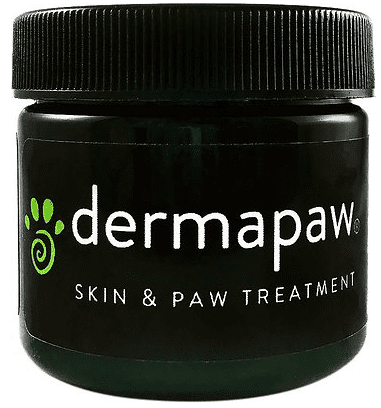*This page may include affiliate links, which means that if you make a purchase through one of the product links, we may receive a small commission. For full affiliate disclosure please see our disclaimer page.
Every dog owner knows the pang of seeing their furry friend in discomfort, scratching at an itchy patch or nursing a sore paw. Our dogs can’t tell us when something’s wrong, but their behaviors and physical symptoms often do the talking. In the world of canine care, the importance of choosing the right topical treatment can’t be overstated. Mupirocin, a common name on the list of ointments prescribed by veterinarians, often comes up as a solution. But, as with every medication or treatment, it’s crucial to understand its uses, benefits, and potential risks. In this comprehensive guide, we’ll dive deep into the world of Mupirocin ointment for dogs. If you’re curious about its safety profile, want to understand its uses, or are searching for over-the-counter alternatives, we have the information you need. Let’s help our four-legged companions lead happier, healthier lives, one paw at a time!
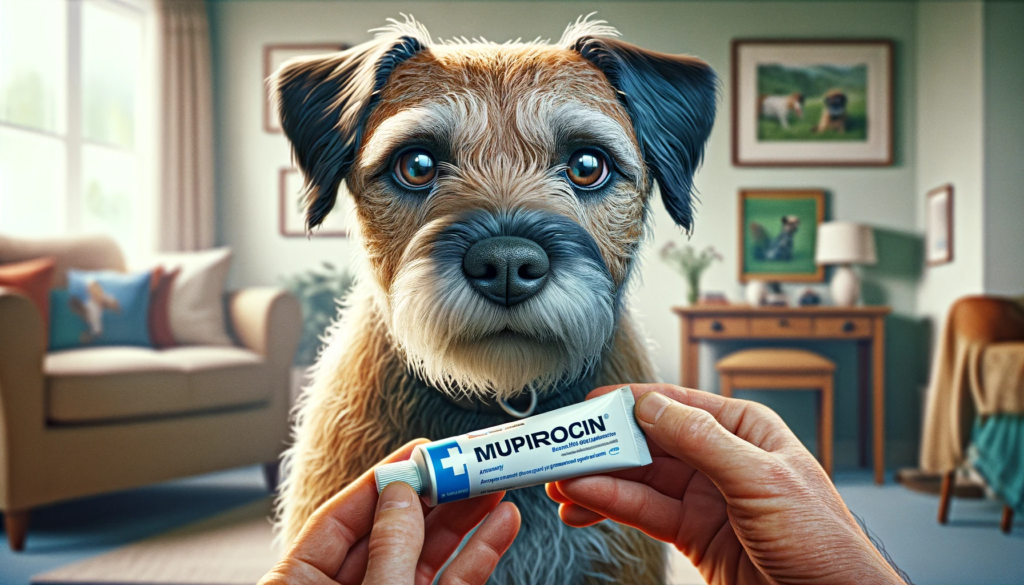
Is Mupirocin Ointment Safe for Dogs?
For those of us with tail-wagging friends at home, their health and safety are paramount. We’re constantly asking ourselves: Is this treat okay for them? Is that toy safe? Similarly, when it comes to medications, we need to be doubly sure. Mupirocin often finds its way into our conversations, especially when dealing with topical infections in our pups. So, is Mupirocin ointment a safe choice for our four-legged buddies?
Mupirocin, initially developed for human use, is an antibiotic ointment that targets a wide range of bacteria, making it a popular pick for various skin conditions. Over the years, vets have recognized its efficacy for dogs too, especially for those pesky bacterial skin infections.
However, like any medication, it’s not a one-size-fits-all solution. The key lies in its appropriate use. A vet will prescribe Mupirocin for a dog after assessing the specific condition, its severity, and the dog’s overall health. It’s essential not to assume that what worked for one dog will work for another, even if the symptoms seem similar. Individual allergies, health conditions, or other medications might influence how a dog reacts to Mupirocin.
In summary, yes, Mupirocin ointment can be safe for dogs when used correctly and under the watchful eye of a veterinarian. It’s a tool in our pet care arsenal, but as with all tools, it’s most effective – and safest – when used with understanding and care. Always consult with your vet and follow the prescribed guidelines to the letter to ensure your pup’s well-being. Because, at the end of the day, a happy dog means a happy home!

Side Effects of Mupirocin on Dogs
Dogs, just like us, have their own unique bodily reactions to medications. Even if a product is deemed safe, it’s always wise to be aware of potential side effects. It allows us to make informed decisions and to spot any unusual changes in our pets swiftly. With Mupirocin, while many dogs handle it well, there can be exceptions. Let’s delve into what to watch out for after applying this ointment to your canine companion.
Common Side Effects of Mupirocin
Dogs, in most cases, tolerate Mupirocin quite well. However, some might experience:
- Redness or Irritation: A mild reaction at the application site which usually subsides on its own.
- Itchiness: Your dog might scratch the area more than usual.
- Mild Swelling: Some puffiness around the application area.
- Temporary Hair Loss: This is especially noticeable if the ointment is applied to a hairy area.
Rare but Serious Side Effects of Mupirocin
While uncommon, it’s good to be alert to the possibility of:
- Severe Skin Reactions: Blistering or oozing at the application site.
- Allergic Reactions: Symptoms could include facial swelling, hives, or difficulty breathing. If these appear, seek veterinary attention immediately.
- Digestive Upset: This can happen if your dog licks the ointment. Signs might include vomiting or diarrhea.
What to Do If Your Dog Exhibits Side Effects to Mupirocin
- Stay Calm: Panicking won’t help, and our dogs often pick up on our emotions.
- Clean the Area: If it’s a mild reaction, gently wipe off the ointment using a damp cloth.
- Document the Reaction: Take pictures and note down the symptoms. This will be helpful when consulting with the vet.
- Seek Veterinary Advice: Always call your vet to discuss any concerns. They might ask you to monitor the situation or bring your dog in for a check-up.
The golden rule is always to observe. After applying any medication, keep a watchful eye on your dog, noting any changes in behavior or appearance. And remember, it’s never an inconvenience to call your vet with questions or concerns. They’re there to help, and your dog’s health and happiness are always the top priority. So, let’s be proactive paw-parents and keep our furry friends feeling their best!

Comparison: Mupirocin for Dogs vs. Humans
We’ve all been there – reaching for a medication in our cabinet, then hesitating, wondering if it’s okay for our furry friend too. This line of thought often emerges with Mupirocin, given its prevalence in human medicine. But how does Mupirocin for dogs stack up against its counterpart for humans? Let’s break it down.
Origins and Similarities of Mupirocin
Developers originally created Mupirocin for human use. It is a powerful antibiotic ointment designed to address various bacterial skin infections. The active ingredient in Mupirocin stays consistent, regardless of its intended use for humans or dogs.
Differences in Formula and Concentration of Mupirocin
While the active ingredient might be the same, there could be differences in:
- Concentration: The strength of Mupirocin might vary based on the intended recipient.
- For more severe human infections, doctors might use a higher concentration, while they might prefer a milder one for dogs to minimize potential side effects.
- Additional Ingredients: The base or other inactive ingredients can differ, potentially affecting absorption or causing irritations in some dogs.
Application and Safety Guidelines
- Duration of Treatment: While a doctor might prescribe Mupirocin to a human for extended use, a vet might limit the duration to prevent potential complications in dogs.
- Frequency of Application: Depending on the severity and type of infection, the frequency of application could differ for dogs compared to humans.
- Safety Precautions: Dogs have a tendency to lick areas where ointments are applied. This ingestion risk is a concern and might not be as pronounced when considering human use.
Why Not to Substitute Mupirocin Without Vet Advice
- Individual Needs: Every dog is unique. What works for one might not work for another, and self-prescribing can be risky.
- Potential Allergies or Reactions: Without a proper vet consultation, you run the risk of exposing your dog to unnecessary side effects or allergic reactions.
- Drug Interactions: Dogs might be on other medications that could negatively interact with Mupirocin.
While Mupirocin ointment for humans and dogs may seem similar, they serve specific needs and may have distinctions crucial to their effective and safe application. Before reaching into our medicine cabinets for a quick fix, always remember our pets deserve the same care and consideration we’d give to any human family member. If you’re uncertain, chatting quickly with the vet can eliminate confusion and ensure you provide the best care tailored to your pet’s needs.
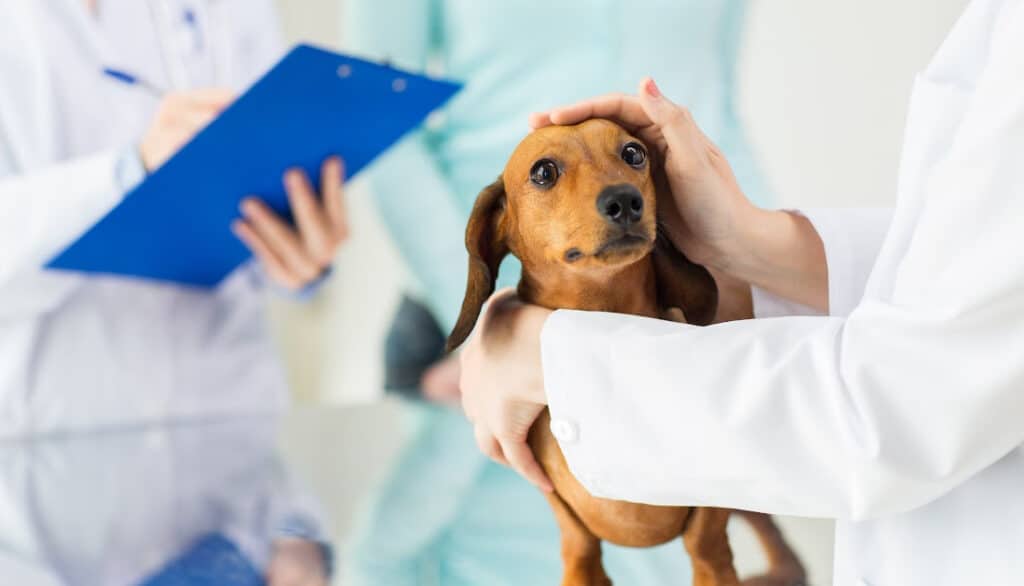
Uses of Mupirocin Ointment in Dogs
A dog’s life, with its joyful romps, curious sniffs, and occasional mischief, isn’t always without its small hitches. Bumps, scratches, and minor infections can come as part and parcel of their adventurous lives. That’s where treatments like Mupirocin come into play. Let’s explore the diverse ways Mupirocin ointment can be a boon for our four-legged friends.
Hot Spots
- What Are They? Hot spots, or acute moist dermatitis, are inflamed, infected, and often painful patches of skin. They can appear rapidly and spread if not treated.
- Mupirocin’s Role: Mupirocin can help in treating the bacterial infections that often accompany hot spots, soothing the area and preventing the spread of the infection.
Ears
- Common Issues: Dogs, especially those with floppy ears, are prone to bacterial infections in the ear canal. This can cause itchiness, redness, and sometimes discharge.
- Mupirocin’s Magic: Applied topically, Mupirocin can address superficial bacterial infections in the outer ear, providing relief and aiding in recovery.
Paws
- Paw Problems: From stepping on rough terrains to allergies, our dogs’ paws can become breeding grounds for infections, especially between the toes.
- How Mupirocin Helps: It acts against bacteria that might infect small cuts or cracks in the paw pads, ensuring that a minor problem doesn’t escalate.
Yeast Infections
- The Yeasty Beast: Caused by the overgrowth of yeast, these infections can lead to itchy and smelly skin, often accompanied by a characteristic reddish-brown discoloration.
- Mupirocin’s Role: While Mupirocin primarily tackles bacterial infections, in combination with antifungal treatments, it can prevent secondary bacterial infections that might arise due to skin damage from persistent scratching.
Open Wounds
- Timely Treatment: Whether it’s a scrape from a tussle with a fellow pooch or a minor cut from exploring, open wounds can become gateways for bacteria.
- Mupirocin to the Rescue: By creating an inhospitable environment for bacteria, Mupirocin helps prevent wound infections, allowing the body to focus on healing.
Mupirocin is like a versatile first-aid kit tailored for our dogs. Its myriad uses make it a potent ally in ensuring our pets’ minor health hiccups don’t transform into bigger issues. However, as always, a vet’s guidance is indispensable. An informed decision, combined with the therapeutic properties of Mupirocin, ensures our dogs continue their romps and explorations with their tails wagging high!
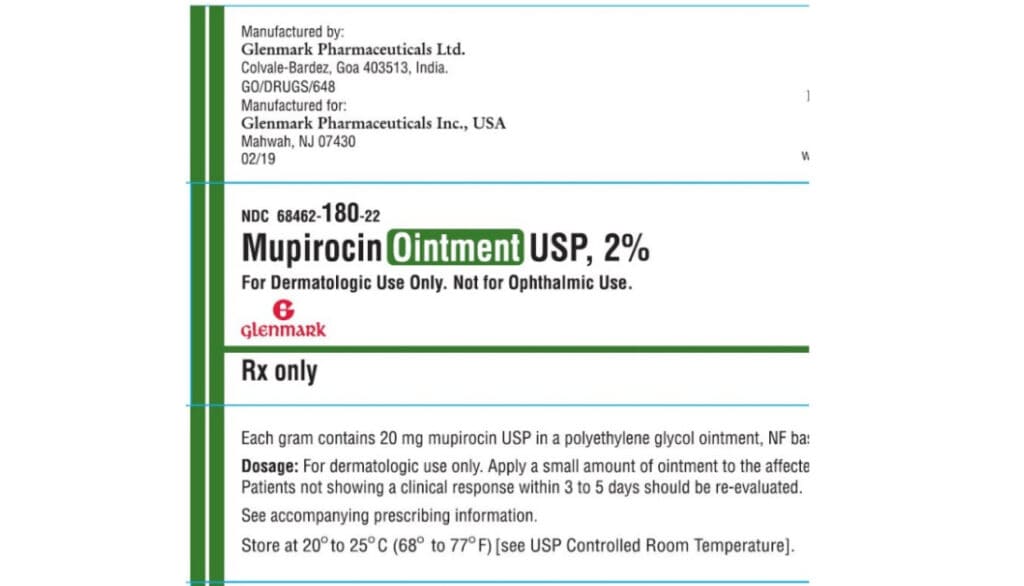
How Should I Use Mupirocin For Dogs?
Ensuring the right method of application for any medication is just as crucial as its ingredients. When it comes to Mupirocin for dogs, this holds especially true. Here’s a step-by-step guide on how to use Mupirocin correctly for your canine companion.
Proper Dosage of Mupirocin
For this medication to work effectively:
- Always give it exactly as your veterinarian has prescribed.
- Double-check the prescription label and package information to ensure you are administering the drug correctly.
Preparation & Application of Mupirocin
- Cleanse: Before applying Mupirocin, cleanse the affected area as instructed by your veterinarian. This ensures optimal absorption and effectiveness.
- Puncture the Tube: When using Mupirocin for the first time, remove the entire applicator assembly. Use the white portion of the cap to puncture the tube, then replace the entire applicator assembly.
- Dispensing: Remove the white part of the cap. Gently squeeze the medicine out of the tube.
- Application: Ensure you apply enough ointment to cover the entire infected area thoroughly. The goal is to create a barrier that prevents further bacterial proliferation.
- Seal: After use, remember to replace the white cap securely to prevent contamination.
Mupirocin Post-Application Care
- Contact Time: The product requires at least 10 minutes of contact time with the affected area to work effectively.
- Avoid Licking: Dogs have a natural instinct to lick wounds. However, ensure your pet does not lick or chew the affected area for at least 20 to 30 minutes post-application. Ingesting the product might lead to side effects.
- Eye Safety: Exercise caution to ensure the ointment doesn’t come into contact with your pet’s eyes. If it does, seek veterinary advice promptly.
Special Instructions
- Duration of Treatment: This medication can be prescribed for various durations. However, according to the label, the maximum duration of treatment is 30 days. It’s crucial to understand how long your veterinarian wants you to continue the treatment. If necessary, make arrangements for prescription refills in advance.
OTC Alternatives to Mupirocin for Dogs
While Mupirocin remains a powerful ally in addressing various skin issues in dogs, it’s not the only tool available. Many pet parents seek over-the-counter (OTC) alternatives for a variety of reasons, from mild cases that don’t require prescription-strength treatment to preferences for more natural solutions. Let’s delve into some OTC alternatives to Mupirocin for our furry pals.
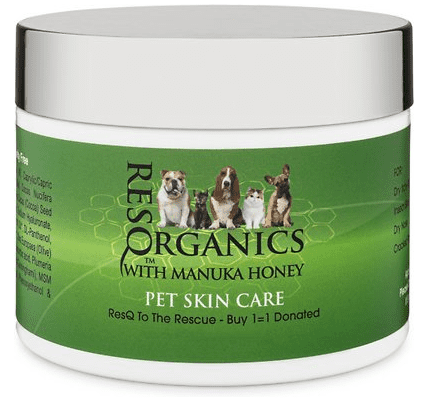
RESQ Organics Skin Care with Manuka Honey
- Best for: Superficial wounds or mild irritations.
- Features: An all-natural, organic product that harnesses the healing properties of Manuka Honey. This honey is renowned for its antibacterial and anti-inflammatory properties, making it an excellent choice for minor skin issues.
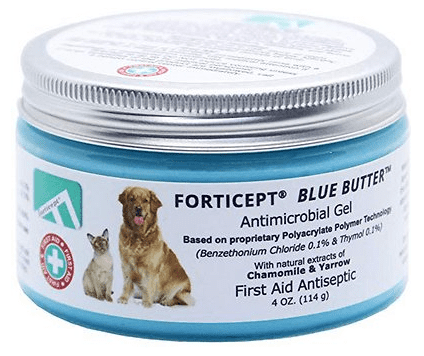
Forticept Blue Butter Pet Wound Filler Antimicrobial Gel
- Best for: Deeper wounds such as those resulting from dog bites or unfortunate encounters with barbed wire.
- Features: This gel provides a protective barrier against germs while promoting a moist environment conducive to wound healing.

Davis Chlorhexidine Dog and Cat Spray
- Best for: Serious infections that might have been overlooked for a day or two.
- Features: Chlorhexidine is a potent antiseptic agent. This spray provides an easy-to-apply solution that can combat various bacterial, fungal, and yeast infections in pets.
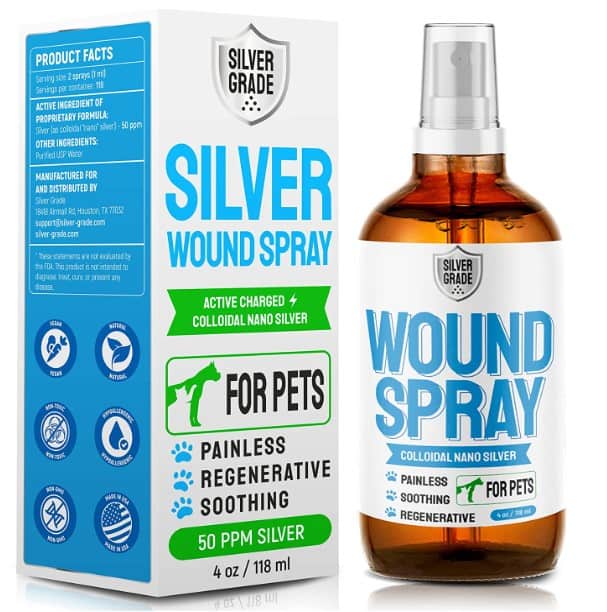
Colloidal Silver Wound and Skin Care for Dogs & Cats
- Best for: Wider wounds with significant skin layer damage where no hair remains. It’s also recommended for wounds under bandages that need to be kept for several days.
- Features: Colloidal silver has been praised for its antimicrobial properties for years. It’s gentle yet effective for promoting the healing of wounds and is a popular choice among natural remedy enthusiasts.
In wrapping up, it’s essential to remember that while OTC products can be incredibly useful, they should not replace a vet’s advice, especially in severe cases. Monitoring your dog’s skin condition is crucial. Regular checks can make the difference between a speedy recovery and a prolonged issue. If you ever feel uncertain or if a wound seems to be worsening, always reach out to your veterinarian. After all, a proactive approach is the key to ensuring our dogs remain happy, healthy, and ever-ready for their next adventure!
Conclusion
Navigating the health and well-being of our beloved canine companions often feels like a journey filled with love, concern, and the constant pursuit of knowledge. With tools like Mupirocin ointment in our pet care arsenal, we’re better equipped to face the minor setbacks that come with a dog’s adventurous life. But, as with every tool, it’s not just about having it—it’s about knowing when and how to use it. Through this guide, we’ve aimed to shed light on the nuances of Mupirocin for dogs, offering insights that empower you, the dedicated pet parent, to make informed decisions. Remember, a proactive approach, combined with regular vet consultations, is the hallmark of exceptional pet care. Because at the end of the day, our ultimate goal is to see our four-legged friends thrive, explore, and live their best lives, with their tails wagging in joy and contentment.
Frequently Asked Questions
The FDA (U.S. Food & Drug Administration) has approved this drug for use in dogs for treating bacterial infections on the skin. The FDA allows veterinarians to prescribe and use products containing this drug in different species or for other conditions in certain situations. You and your veterinarian can discuss why this drug is the most appropriate choice.
Many things might affect how well this drug will work in your animal. Be sure to discuss the following with your veterinarian so that together you can make the best treatment decisions.
– Other drugs can interact with this medication, so be sure to tell your veterinarian and pharmacist what medications (including vitamins, supplements, or herbal therapies) you give your animal, including the amount and time you give each.
– Tell your veterinarian about any conditions or diseases your animal may have now or has had in the past.
– If your animal has been treated for the same disease or condition in the past, tell your veterinarian about the treatment and how well it did or didn’t work.
– If your animal is pregnant or nursing, talk to your veterinarian about the risks of using this drug.
– Tell your veterinarian and pharmacist about any medication side effects (including allergic reactions, lack of appetite, diarrhea, itching, hair loss) your animal has developed in the past.
This medication should start having effects within 1 to 2 hours; however, you may not see the effects of this medication outwardly. Your animal should begin feeling better within 1 to 2 days. The effects of this medication are short-lived, meaning they will stop working within 24 hours.
No drug is 100% safe in all patients, but your veterinarian will discuss with you any specific concerns about using this drug in your
animal.
This drug SHOULD NOT be used in patients:
– That are allergic to mupirocin or polyethylene glycol.
This drug should be used WITH CAUTION in patients:
– With extensive or deep skin wounds or sores.
– That are pregnant or used for breeding.
If your animal has any of these conditions, talk to your veterinarian about the potential risks versus benefits.
Side effects that usually are not serious include:
– Pain, redness, and itching at the application site.
If any of these signs are severe, worsen, or continue to be a problem, contact your veterinarian.
Side effects that may be serious or indicate a serious problem:
– Increased thirst and/or urinating more than usual
– Vomiting
– Poor appetite
– Low energy level
– Worsening of the skin problem
If you witness or suspect an overdose or accidental ingestion of the product, contact your veterinarian or an animal poison control center for further advice. Animal poison control centers open 24-hours a day include: Pet Poison HELPLINE (855-764-7661) and ASPCA Animal Poison Control Center (888-426-4435); a consultation fee may be charged for these services.
– Store this medication in the original prescription bottle or an approved dosage reminder container (ie, pill minder) at room temperature (between 59°F 86°F) and protected from light.
– If your veterinarian or pharmacist has prepared (compounded) a special formulation for your animal, follow the storage recommendations and expiration date for the product.
– Keep away from children and other animals.
– Do not allow children to handle product.
– May cause skin irritation and eye irritation. Skin irritation may be worse in individuals with pre-existing skin conditions.
– Gloves are not required to apply this product, but may be considered if there are any concerns.
– Wash hands after handling this or any medication.
– Avoid contact with eyes.
– Do not flush this medication down the toilet or wash it down the sink. If a community drug “take-back” program is available, use this option. If there is no take-back program, mix the drug with coffee grounds or cat litter (to make it undesirable to children and animals and unrecognizable to people who might go through your trash), place the mixture in a sealable plastic bag to keep it from leaking out and throw the bag out with the regular trash.
– Do not save leftover medication for future use or give it to others to use

